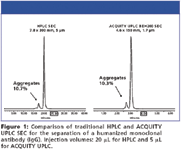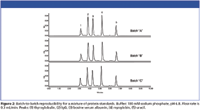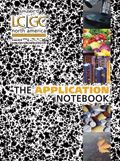Analysis of Biomolecules by Size-Exclusion UltraPerformance Liquid Chromatography
In the production of biopharmaceuticals, there may be different analytical requirements for groups performing clone section, formulations and stability, and quality control (QC).
Kenneth J. Fountain, Paula Hong, Susan Serpa, Edouard S. P. Bouvier, and Damian Morrison, Waters Corporation
In the production of biopharmaceuticals, there may be different analytical requirements for groups performing clone section, formulations and stability, and quality control (QC). Depending on the goal of the separation, methods may be optimized for fast analysis time, highest possible resolution, and/or reproducibility. Size-exclusion (SEC) chromatography is often used throughout the biopharmaceutical production process for the analysis of proteins and their aggregates. While SEC has traditionally been used in conjunction with low pressure HPLC instrumentation, the advent of UPLC® Technology and new sub-2 μm packing materials allows for substantial improvements in chromatographic resolution and throughput. This application note will demonstrate the use of the new ACQUITY UPLC® SEC solution for the improved detection and/or faster analysis of protein aggregates in biopharmaceuticals.

Results and Discussion
Figure 1 shows the chromatographic comparison of traditional HPLC and ACQUITY UPLC for the separation of a humanized monoclonal antibody. Equivalent aggregate quantification in significantly shorter run times is possible with the ACQUITY UPLC SEC solution as compared to traditional SEC. This is especially important for those scientists performing clone selection who may need increased throughput for large numbers of samples.

Figure 1
In regulated environments, the use of SEC is often required for the characterization of biopharmaceutical therapeutics. Given these demands, columns are expected to be reproducible from batch-to-batch and have long lifetimes. Figure 2 shows the batch-to-batch performance for three different batches of 1.7 μm, BEH200 SEC packing material. These data show the consistent performance of the BEH200 SEC columns regardless of the batch of material being used, which provides confidence for those performing aggregate determination in biopharmaceutical drugs. Figure 3 demonstrates the lifetime of the ACQUITY UPLC BEH200 SEC columns with the same humanized IgG sample shown in Figure 1. No deterioration in peak shape or retention was observed, which ensures accurate identification and quantitation of the antibody monomer and dimer over several hundred injections.

Figure 2
Conclusions
The Waters ACQUITY UPLC SEC solution provides the speed, resolution, and sensitivity of UPLC for proteins (antibodies) in a molecular weight range of 10,000 to 450,000 Daltons. It can be adapted to varying requirements of run time and resolution that are often needed in clone selection and/or quality control testing. This work extends UPLC technology to a wider range of bioseparations.

Figure 3
©2010 Waters Corporation. Waters, The Science of What's Possible,
ACQUITY UPLC and UPLC are trademarks of Waters Corporation.

Waters Corporation
34 Maple Street, Milford, MA 01757
tel. (508)478-2000; fax (508)478-1990
Website: www.waters.com

SEC-MALS of Antibody Therapeutics—A Robust Method for In-Depth Sample Characterization
June 1st 2022Monoclonal antibodies (mAbs) are effective therapeutics for cancers, auto-immune diseases, viral infections, and other diseases. Recent developments in antibody therapeutics aim to add more specific binding regions (bi- and multi-specificity) to increase their effectiveness and/or to downsize the molecule to the specific binding regions (for example, scFv or Fab fragment) to achieve better penetration of the tissue. As the molecule gets more complex, the possible high and low molecular weight (H/LMW) impurities become more complex, too. In order to accurately analyze the various species, more advanced detection than ultraviolet (UV) is required to characterize a mAb sample.

.png&w=3840&q=75)

.png&w=3840&q=75)



.png&w=3840&q=75)



.png&w=3840&q=75)













